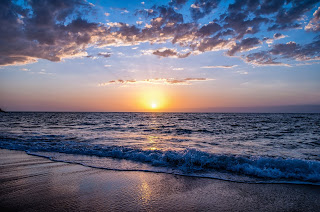This lesson is an exercise for painting an impressionist work.
You need:
- white drawing sheet
- tempera paint in red, blue and yellow
- small brushes
- paper towels
View impressionist paintings, for example from Claude Monet or Van Gogh. Zoom into Starry Night from Van Gogh using this link.
What do you see?
- the painting is made out with loose dashes.
- the dashes indicate a direction or movement, they are not just placed.
- you can see the canvas between the dashes. The color of the canvas is therefore part of the painting.
View a sunset picture.
What do you see?
- the sun is reflected in the water
- the sun's rays point left, up and right
- the horizon is half way the photograph
Exercise before you get started:
- Practice painting short strokes on a scrap. To do this, always lift the brush from the paper.
- Practice with two colors on your brush; do not mix!
- Make narrow / wide strokes by turning / not turning your brush.
- Clean the brush for a new color with a paper towel, do not use water!
And now the artwork:
- Fold your drawing sheet in half lengthwise, this is the horizon line.
- Draw with pencil a semicircle on the horizon line, this is the sun.
- Paint the sun orange: apply red and yellow to your brush. Do not mix!
- Paint the sun's rays with yellow and very little red. Put something on your brush of both colors and make short strokes by lifting the brush from the paper each time. Also leave white between the strokes.
- Also make the reflection of the sun in the water. Beware: the direction of the brushstrokes is now horizontal, just like the water.
- Make the sky with blue and white (again add two colors to the brush). Use white to make a lighter blue. Follow the direction of the sun's rays. Don't make the sky completely full, you have to keep seeing paper.
- Paint the sea with blue, white (and maybe green). Do not mix! The direction is horizontal here. Think of the white space between the lines.
Elements of art: line, color, nuance.



Geen opmerkingen:
Een reactie posten